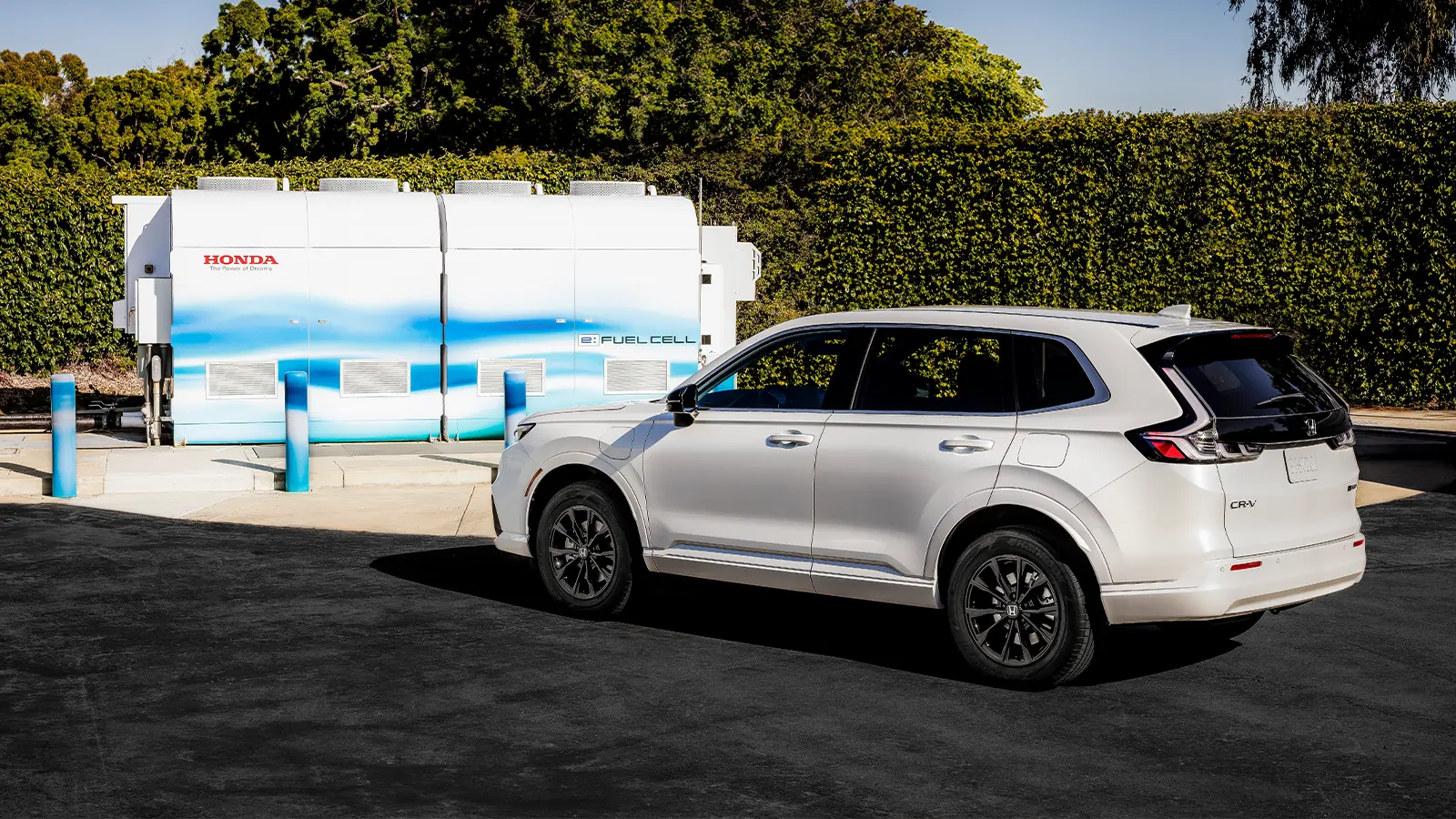Honda’s New Hydrogen SUV
Hydrogen fuel cell vehicles in theory offer the best of both worlds. Converting compressed hydrogen into electricity using an on-board fuel cell stack, they offer the zero-emissions benefits of electric driving with the convenience of quick refueling. On a road trip? Stop at a hydrogen station for a couple of minutes and you’re back on the road. The latest entry into the market for hydrogen-powered vehicles is Honda’s CR-V e:FCEV, a hydrogen fuel-cell powered CR-V crossover, and it’s now available for lease.

Hydrogen CR-V: Drivetrain
Compared to other hydrogen vehicles, what makes the CR-V e:FCEV special is its fueling flexibility. Hydrogen fuel cell vehicles like the Toyota Mirai and Hyundai Nexo rely solely on hydrogen fuel, converting it to electricity on-board to power to power their electric motors. While the hydrogen CR-V has an on-board fuel cell to generate electricity, it also has a substantial battery that can be charged by plugging it in – providing drivers with more “refueling” options. Indeed, the on-board battery gives up to 29 miles of fully-electric driving around town, the fuel cell gives drivers the ability to go an estimated 270 miles, according to the EPA, with quick refueling at hydrogen stations for longer trips.
The 2025 CR-V e_FCEV is front-wheel drive only. With a single electric motor producing 174 hp and 229 lb-ft of torque, it accelerates quickly and smoothly while delivering impressive efficiency.
Honda’s engineers tuned the hydrogen CR-V’s structure and suspension to deliver the same engaging driving experience and refinement as gasoline and hybrid CR-V models. The body is actually more rigid in the rear, while torsional rigidity has also improved. The MacPherson struts in the front and the multi-link suspension in the rear have also been completely re-tuned for the hydrogen fuel cell setup, ensuring a smooth ride and responsive handling.
Next-Generation Fuel Cell
The hydrogen CR-V is the first application of Honda’s second-generation fuel cell module, which is produced in Michigan. The company says that the new fuel cell offers improved durability, higher efficiency, increased refinement, and lower cost compared to Honda’s previous-generation fuel cell, which was used in the Clarity FCEV.
The fuel cell was actually co-developed with General Motors, leveraging the know-how of both companies, which has led to substantially reduced costs in for the CR-V e:FCEV. New materials were developed for the fuel cell’s electrodes, and improved sealing methods also make the system safer. The system is said to be much more durable thanks to the application of more corrosion-resistant materials, and it works much better at low temperatures.
Honda is one of the industry leaders in fuel-cell technology. The world’s first publicly-available hydrogen fuel cell vehicle, the Honda FCX, was introduced in December 2002, and the company has also sold the Clarity fuel cell vehicle in the U.S. for many years.

Honda CR-V e:FCEV Design and Technology
While it’s based on the familiar CR-V design – currently available in gasoline and hybrid variants – the hydrogen CR-V has a look all its own. In fact, it has completely new body panels at the front, including a new bumper, a low, upright grille design and long hood for an aggressive, sleek look. The rear is also different, with a distinctive rear bumper and a unique tailgate design. Underneath, the entire underbody has an aerodynamic cover for improved efficiency and range. 18-inch, 10-spoke black alloy wheels are also unique to the CR-V e:FCEV.
There are fewer changes inside the hydrogen CR-V, which carries over the excellent, high-quality interior from other CR-V models largely unchanged, with its striking full-width mesh vent. The 10.2-inch digital instrument cluster has some unique displays dedicated to the hydrogen fuel cell system, while the 9-inch touchscreen has Apple CarPlay and Android auto compatibility. There’s also a wireless charging pad, heated seats and steering wheel, dual-zone climate control, and a 12-speaker audio system. The seats are covered in bio-based leather upholstery, more sustainable than conventional leather.
Standard safety features include the Honda sensing suite of driver assistance technologies, which includes automatic emergency braking, lane departure warning, active cruise control, and other useful features. The CR-V e:FCEV’s navigation system has extended capabilities including hydrogen fueling station information and charging and power supply data. An on-board power supply has a 110-volt power outlet means that the hydrogen CR-V can become a clean power source that can run small appliances, portable air conditioners, power tools, camping equipment, and more – or just charge your laptop.
What Are the Disadvantages of Hydrogen?
The one caveat about the impressive CR-V e:FCEV is that it’s currently only available in California – and it’s only available to lease, not buy. While hydrogen technology has many advantages, fueling infrastructure is far behind both gasoline and EV charging infrastructure across the U.S. Indeed, there are fewer than 100 publicly-accessible hydrogen fueling stations across America – and almost all of them are in California. With Shell recently announcing it would close a number of its hydrogen stations, the fuel’s availability for public users is being reduced, not improved.
Still, if you do live in California, and your specific use case involves frequently needing to drive long distances without having to stop for too long, the hydrogen-powered Honda CR-V may be a great fit for you. It has everything that makes the CR-V a great crossover SUV, plus zero-emissions capability enabled by charging as well as hydrogen refueling. For some drivers, it truly is the best of all worlds.














